“These (images of my hand and arm below) are just some of the more common physical effects of Morgellons. There are others as well. Additionally, the psychological and internal physiological effects are equally as devastating.”
– Morgellons patient
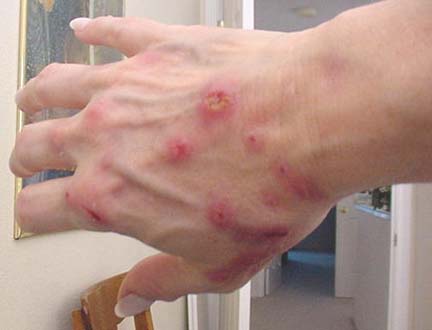
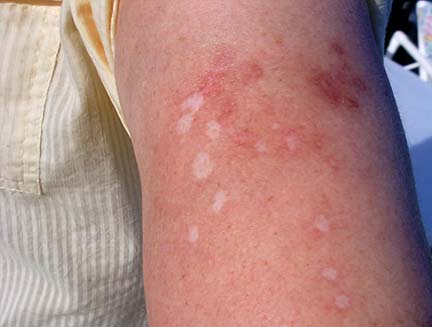
June 22, 2006 Tulsa, Oklahoma – At the end of April 2006, a 23-year-old man in Texas named Travis Wilson killed himself after suffering for a year with the painful, itching syndrome called “Morgellons disease.” He said it felt like bugs were crawling under his skin. None of the antibiotics and medicines he tried stopped his agony.
The highly strange Morgellons disease did not rise to public consciousness until the past few years. This afternoon I talked to a senior communications officer at the Centers for Disease Control. He said tht Morgellons syndrome is finally being acknowledged by CDC as a public complaint that needs to be studied. For the first time, a medical working group has been assembled at CDC to specifically investigate the Morgellons syndrome and that group’s first meeting is next week. CDC also now has an e-mail address for the public. It is: [email protected]
The non-profit Morgellons Research Foundation at Oklahoma State University has more than 4,000 people now registered as sufferers. The largest percentages are nurses and teachers.
Recently, I talked with a Morgellons patient who has worked as a nurse for 26 years. Cindy Casey has been a full time registered nurse specializing in critical care since 1990. Three years ago, she began to itch, especially on her legs between her knees and ankles. Then sores opened which she scratched so hard, scars formed. She also said it felt like bugs crawling beneath her skin and the painful itch was so bad that she could not sleep. The weight of clothes against her skin was even painful. Cindy is now on medical leave from California Pacific Medical Center’s critical care unit. She is a volunteer staff member for the Morgellons Research Foundation and described for me her firsthand experience with Morgellons disease.
Interview:
Cindy Casey, Registered Nurse, Now On Medical Leave from California Pacific Medical Center’s Critical Care Unit, Hughes Springs, Texas: “The itching is so intense! It was unlike anything I had ever had. I’ve had poison ivy and some things that itch pretty bad, but this was unlike anything I’d ever had. It’s an itching and crawling sensation. It actually feels like something crawling under your skin.
And this is kind of the problem because that’s the best way to describe the sensation, yet when you say that to a physician, they automatically put yo in a category as “delusions of parasitosis.” This is what they’ve been taught in medical school – that people who have crawling sensations, or think they have bugs (in their skin), are delusional. Now here I am a nurse, and I’m not hallucinating! It’s so frustrating!
And these (symptoms) continued on and got worse and worse. And the skin lesions came up. First, it was kind of intermittently. And then like the past three years is when I became full blown skin lesions all over my body. The most unusual part of this is the unusual fibers that you can see emerging from the lesions.
CAN YOU DESCRIBE HOW YOU FIRST TRIED TO REMOVE THEM FROM YOURSELF? WHAT DID IT FEEL LIKE AND HOW DIFFICULT IS IT?
It’s pretty difficult. I would take tweezers and try to remove these fibers. It’s very difficult. They have like a substance on them that is connected into the tissue. A lot of people have pulled long fibers out that are macroscopic. I do have a few that can barely be seen with the naked eye, but you CAN pull them out with a good pair of tweezers. That’s the only thing you get relief from these lesions is when you can pull these fibers out.
AND ONCE YOU’VE PULLED THEM OUT, HOW LONG IS IT UNTL ANOTHER ONE EITHER COMES BCK IN THE SAME PLACE, OR NEARBY?
Within 24 hours, and maybe even within 12 hours, I’ve noticed before. They are very fast-growing microscopically. They resemble the hyphae of fungus, but they don’t fit any fungus that’s ever been described. It’s too large. But it’s almost like a moldy-like substance.
When he (Dr. Wymore) began to try to culture it, nothing grew. So, PCR tests were difficult because he did not know a particular organism to look for. Even forensic labs are just at a loss for having any answers. It does not match any, absolutely no textile that is known. I thought analysis would be a lot quicker.”
[ Editor’s Note: Wikipedia – “Polymerase chain reaction (PCR) is a molecular biology technique for enzymatically replicating DNA without using a living organism, such as E. coli or yeast. Like amplification using living organisms, the technique allows a small amount of the DNA molecule to be amplified exponentially. However, because it is an in vitro technique, it can be performed without restrictions on the form of DNA and it can be extensively modified to perform a wide array of genetic manipulations. PCR is commonly used in medical and biological research labs for a variety of tasks, such as the detection of hereditary diseases, the identification of genetic fingerprints, the diagnosis of infectious diseases, the cloning of genes, paternity testing, and DNA computing.”]
Analyzing what the bizarre Morgellons fibers are has been slowed down by the fact that Dr. Randy Wymore has a fulltime job as an Asst. Prof. of Pharmacology and Physiology at Oklahoma State University in the College of Osteopathic Medicine. [ Focus on relationship of nereves, muscles, bones, connective tissue and organ systems.]
He works on Morgellons as a volunteer with a couple of graduate students, provoked after he saw the fibers under a microscope for the first time a year ago and knew he had never seen anything like it before.
The fibers are most often clear, but sometimes blue or red. Currently, volunteer researchers are applying what is called “Fourier Transform Infrared Spectroscopy,” or FTIR, in an effort to find out what the Morgellons skin fibers are.
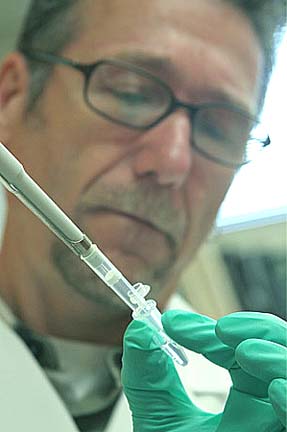
Interview:
Randy Wymore, Ph.D., Asst. Prof. of Pharmacology and Physiology, Oklahoma State University, College of Osteopathic Medicine, and Director, non-profit Morgellons Research Foundation, OSU: “We have solicited the help of the local police crime lab because they do FTIR spectroscopy and they do metal analysis because one possibility is that the colors are not pigments per se. They are NOT dye, that much is clear. But maybe they are so homogenous in color because it’s actually a metal in a particular ionized state that gives the colored appearance. So, we’re just waiting for them to do these experiments.
The most common are not colored at all – or they have a slightly brownish to darkish apperance to them. The ones that are the most striking are the blue and red ones because they so stand out. The blues are often – they are just incredibly bright – almost an electric blue.
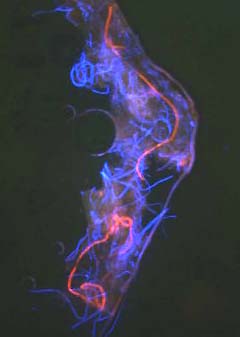
THE REDS ARE VERY DEEP RED, OFTEN ALMOST MAGENTA-COLORED. BUT SO FAR, NO ONE HAS AN I. D. OF A SPECIFIC ELEMENTAL COMPOSITION ON WHAT ANY OF THEM ARE?
No. Some FTIR spectroscopy has been done, but until it’s replicated, we can’t really discuss that. It s unfortunate that lesions with bizarre-looking fibers are such a big part of this story. I know from looking at bizarre disease, it really stands out. But what I think is a really awful effect that is taking place with people suffering from Morgellons is that there are neurological effects.
Many of these patients are very much like people with diabetes who have uncontrolled bouts of diabetes. There is peripheral nerve damage so they have that pins and needles tingling in their feet, fingers and toes. They have difficulty sometimes feeling things in their periphery, all the way to muscle effects where certain peripheral muscles in their feet and lower legs make it difficult for them to walk. I’ve seen now a couple of Morgellons sufferers who have very pronounced foot drop. That is when they lift their leg up to take a step, their foot just drops at the ankle. They have to take an exaggerated step to place their foot down to take the next step so they don’t trip over their own feet.
The (patients) also have central neurological effects – something they have coined a name for: ‘brain fog.’ It’s just a profound difficulty in focusing, clear to the point where some patients actually manifest period of time where they have difficulties forming words and communicating.
IS THIS WHY IN THE LAST FEW MONTHS, THERE HAS BEEN SOME DISCUSSION ABOUT A LINK POSSIBLY TO LYME DISEASE?
I think the initial link of those Morgellons patients, which have been tested for Lyme disease, there seems to be a high coincidence of it. Now, whether or not Lyme disease has anything to do with Morgellons, I have no idea.
People who have Morgellons disease are very sick. There are skin manifestations and nervous system manifestations. It might be communicable or contagious. It can’t be highly contagious, in the same sense like influenza. But then it’s a mystery. We have some whole families where every single family member, including in-laws, non-blood relatives, sometimes have it.
But then, we have other families where a husband or wife significant others have been together for 2, 4, 6 years, or in some cases with children, that don’t have it. So, very puzzling!
But I am going under the assumption that at the root of this there is an environmental cause, a genetic – either predisposition, or a protective, factor. And then, any other usual suspects in terms of contagious sorts of elements such as bacterial, viral, protozoan, worms. Nothing really has been eliminated for me, except for – in terms of causative agents – I do not believe (it’s) one of the little bugs called collembola (arthropod). A lot has been written about it. But we can’t amplify the DNA from collembola in any of the scabs or shed material or fibers from patients. So, I don’t believe it’s that. But as far as what the causative organism is, I have no idea.
A lot of physicians are still at the point of sending e-mails and calling and saying, ‘Well, why in the world do you think this could be real?’
For myself, physicians and others here at Oklahoma State University Center for Health Sciences, we’ve moved way beyond that point and now are trying to approach the research as to how do we figure out what’s going on?
In all honesty, it gets tedious trying to defend the fact that this is a real condition, as opposed to something that is purely delusional. Because we know it’s not (delusional). People say, ‘How sure are you that this is a real disease?’ Well, the people are suffering horribly! Obviously, it’s real. Something is going on here.
But in terms of: Is it something physical that we can try to work at and try and test and try and figure what’s going on? After I got to witness an examination and see what we were seeing, I have NO doubt whatsoever as to the reality of Morgellons disease!
Just a couple of weeks ago, I think over about a 10-day period, we had 341 or so new registrations in that short period of time. And the majority of them were at least two people per registration, all the way up to in one case, one registration represented six family members.
AND THERE YOU ARE BACK TO THE MYSTERY OF CLUSTERING. IS THIS SOMETHING THAT IS INFECTIOUS?
Right. While I am sort of investigating something that a lot of people think is sort of on the fringe side, the approach we are using to investigate is very much mainstream medicine as we try to sort through this and from that mainstream medicine’s perspective, I can’t really address the specifics on that (infectious?) because we just don’t know.
AND WHY WOULD SOMETHING THAT’S AFFECTING 4,000 PEOPLE AND COUNTING BE CONSIDERED FRINGE?
Because of the seeming impossibility of the symptoms. I am totally unhappy with the way physicians just dismissed the symptoms of Morgellons disease and then dismissed their patient.
But on the other hand, as far as saying if you were a physician and someone said: ‘I have red and blue fibers growing out of my skin.’ A certain healthy skepticism is not unwarranted there. For most of us, we would say, ‘No, that’s not possible.’
Now, that being said, it does get back to the physician who should do a thorough diagnostic work up. With a $10 handheld microscope from your typical electronics store, you can see even the larger microscopic fibers in the skin with the hand-held microscope. So, it’s not even the matter of having the right equipment to be able to look at it. But what it does take is actually looking. And that’s what most of the physicians who have immediately reached for the ‘diagnosis of parasitosis’ have done. They have not gotten close enough to look at the skin. They definitely have not looked with a magnifying glass, or a microscope.
Because if they did, they would see things in the skin that when you look at someone who is unaffected and does not have Morgellons disease, you just don’t see these. Something is definitely going on here.”
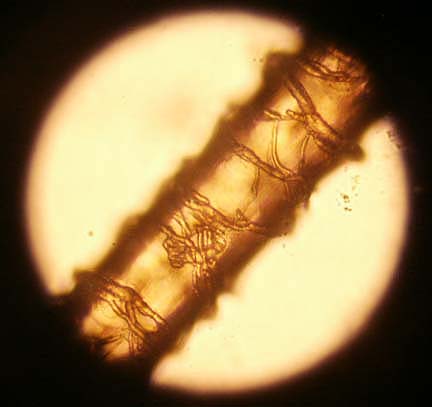
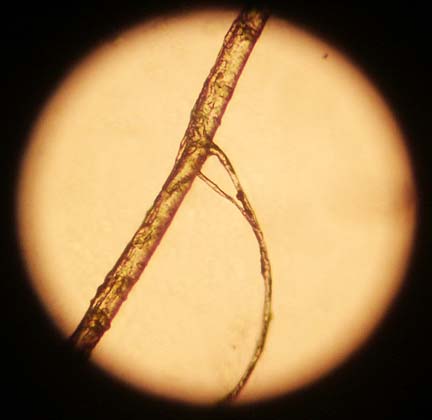
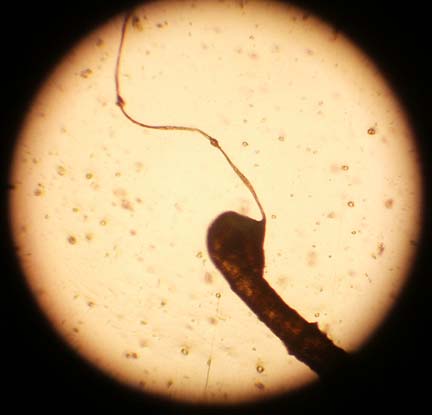
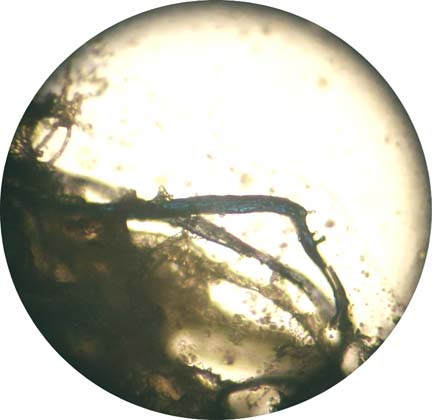
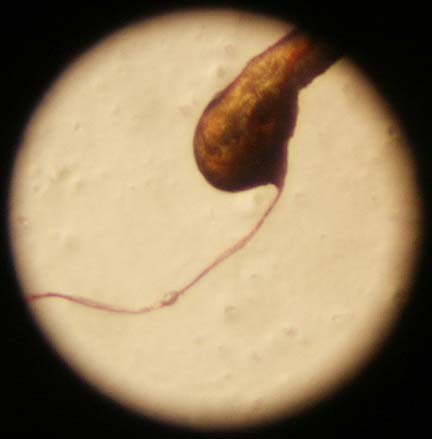
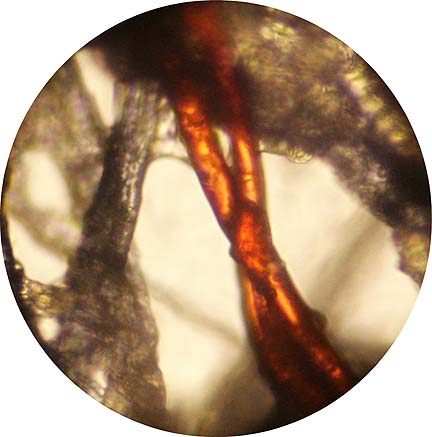
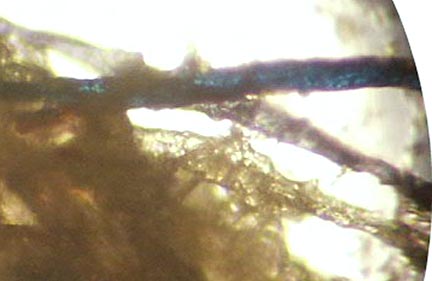
Website:
Morgellons Research Foundation: http://morgellons.org/index.html
© 1998 - 2024 by Linda Moulton Howe.
All Rights Reserved.

